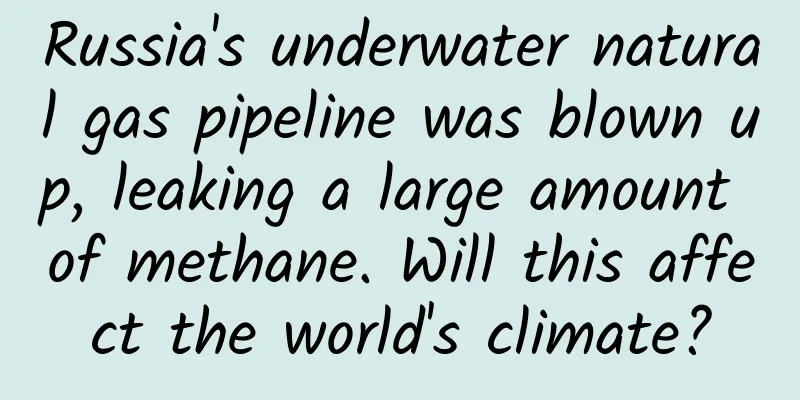Russia's underwater natural gas pipeline was blown up, leaking a large amount of methane. Will this affect the world's climate?

|
On September 26, local time, explosions occurred simultaneously on the Nord Stream 1 and Nord Stream 2 gas pipelines in the waters near Denmark and Sweden, causing a large amount of natural gas leakage. Denmark and Sweden launched an emergency investigation and released a report on September 30, pointing out that the leakage of the natural gas pipeline was caused by an underwater explosion equivalent to hundreds of kilograms of explosives, with an explosion intensity of 2.3 and 2.1 on the Richter scale, respectively, and these explosions were intentional. These are two roughly parallel submarine natural gas pipelines that start from Russia and connect to Germany. They pass through the waters near Denmark and Sweden and are more than a thousand kilometers long. They are an important channel for Russia to export natural gas to Europe. The pipelines were destroyed. One has to buy and the other has to sell. Of course, the ones most affected are Russia and Europe, which indicates that no one will have an easy winter. Which country, organization or individual planned and created this incident? The international community is in a state of turmoil, with some major countries also blaming each other. Today we will not discuss which country or individual was responsible, but will objectively analyze this incident from a scientific perspective and what impact it will have on the future climate. As the saying goes, when the city gate catches fire, the fish in the pond will be affected. Don’t think that many events happening in the world are far away from us and will not have any impact on us. In fact, there is a butterfly effect, and the uncertainty factors in the chaos will magnify each event. It is like a group of fish that were leisurely enjoying their life, and suddenly saw flames rising from the city gate. They thought it had nothing to do with them, so they just scrambled to stick their heads out to watch the fun. Unexpectedly, people coming to fetch water to put out the fire came and quickly scooped out the water in the pond. The fish died before they could figure out what was going on. Who knows if something that happens in faraway places in the world will affect us one day? Therefore, when we see something, we should never think that it has nothing to do with us. We should still pay attention to it. So, today we will pay attention to the natural gas leak in the Baltic Sea and what impact it will have on the world. The earth is experiencing a climate warming disaster, and the main culprit is greenhouse gases. The so-called greenhouse effect means that the Earth's atmosphere is like a big glass cover covering the Earth. When sunlight radiates energy to the Earth's surface through the glass cover, the atmosphere and the Earth absorb part of it, and most of it is reflected back into space. Because of the glass cover, some of it is blocked, which keeps the Earth's temperature higher. The Earth's atmosphere has always had a greenhouse effect. Without the atmosphere, the average surface temperature would drop to minus 23 degrees Celsius. However, for hundreds of years, the annual average surface temperature has remained at around 15 degrees Celsius, allowing people to live comfortably in this home. This is a balance between solar radiation and absorption and reflection. However, as the concentration of greenhouse gases in the atmosphere increases, this balance is broken. If water vapor is excluded, the contribution of other major greenhouse gases is: carbon dioxide (CO2) accounts for about 55%; methane (CH4) accounts for about 15%; nitrous oxide (N2O) accounts for about 6%; chlorofluorocarbons (CFCs), also known as Freon, account for about 24%. It can be seen that apart from these major greenhouse gases, the contribution of other gases is extremely small and almost negligible. Greenhouse gases can absorb more infrared radiation, that is, the energy from the sun that hits the earth will be reflected back to space in the form of infrared radiation. As more and more of it is intercepted by greenhouse gases, the temperature of the earth will naturally rise. The main reason for the increase in greenhouse gas concentrations is the burning of fossil fuels in human activities, which produces a large amount of greenhouse gases that continue to accumulate in the atmosphere. These greenhouse gases are mainly produced since human industrialization. According to historical monitoring, due to the rapid increase in greenhouse gases caused by industrialization, the average surface temperature has risen by about 1 degree Celsius compared to before industrialization. Even though this small increase has caused glaciers to melt and sea levels to rise, extreme weather conditions to occur frequently, and climate disasters to become more frequent. In addition to carbon dioxide, methane plays an important role in the increasingly serious greenhouse effect. The greenhouse effect of methane is 10 to 26 times that of carbon dioxide, but because the concentration of methane in the atmosphere is much lower than that of carbon dioxide, only about 1/160 of the latter, it is second in the contribution to the greenhouse effect. The concentration of freon in the atmosphere is much lower than that of methane, but because its greenhouse effect is 3,400 to 15,000 times that of carbon dioxide, its contribution rate is much higher than that of methane. Scientific research shows that the threshold for temperature rise is 3 degrees Celsius, which means that a 3-degree rise in temperature compared to pre-industrial times is the critical point. When this critical point is reached, the earth's climate self-regulation system will collapse, extreme climate disasters will occur, mass extinction of species will be inevitable, and humans will not be able to escape. Therefore, reducing the greenhouse effect and slowing down or stopping the temperature rise has become a consensus among countries around the world. To achieve this, energy conservation and emission reduction are needed to achieve carbon balance. Currently, the most important thing is to reduce the emission of greenhouse gases such as carbon dioxide and methane. Since the greenhouse effect of methane is much higher than that of carbon dioxide, reducing methane emissions is more important than reducing the same amount of carbon dioxide emissions. Under this severe situation, the leak of the Nord Stream natural gas pipeline is tantamount to making the greenhouse effect worse. Natural gas is composed of about 85% methane, and the rest is ethane and propane, accounting for about 12%, both of which are highly potent greenhouse gases. Therefore, this leak is not a question of whether it will have an impact, but a question of how big the impact will be. So, how big is the impact of this methane leak? According to media reports, on the day of the Nord Stream submarine pipeline explosion, operators saw a rapid drop in pressure, and soon the bubbles escaping from the Baltic Sea reached a width of 1 kilometer. This shows that the leaked natural gas escaped from the seabed to the sea surface and dissipated into the atmosphere. Because the two sections of the pipeline were out of service, the natural gas in the pipeline was stored in the pipeline to maintain the pipeline pressure, and now it has all escaped. According to the assessment, the total amount of methane leaked is about 115,000 tons. As a result, some industry experts have issued climate alarms. Andrew Baxter, a former oil and gas industry engineer who is now director of the Energy Center at the Environmental Protection Fund in New York City, believes that the overall impact of the leak is equivalent to the annual carbon emissions of 2 million cars. 2 million cars is about the number of cars in a large or medium-sized city, and such emissions will certainly not change the world pattern. Zeke Hausfesser, a geoclimate scientist at the University of California, Berkeley, also pointed out that although this is the largest natural gas leak in history, it has not fundamentally changed the scale of global emissions. However, since the methane leaked this time is concentrated in one area and has a process of dilution and diffusion, it is likely to affect the local climate in the leaking area. In fact, from common sense, we can also get this result. We know that the total mass of the atmosphere is about 600 trillion tons, of which nitrogen and oxygen account for about 99% of the atmosphere. The remaining 1% is composed of dozens of other gas molecules and water vapor, of which carbon dioxide accounts for 0.032% and methane accounts for 0.0002%. That is to say, in the total mass of the atmosphere, there are 12 billion tons of methane. The methane leaked this time was about 115,000 tons, accounting for only about 0.001% of the total atmospheric methane. The annual global methane emissions reach 50 million tons (including animal farts). No matter from which angle you look at it, the methane leaked this time is a very small number, and of course it will not fundamentally change anything. Even so, such incidents have once again sounded the alarm for mankind. We should see that such accidents are not unique, and many accidents are or will continue to occur, such as forest fires and wars. It is precisely many such events that, when added together, will change the world. Spacetime Communications believes that only by keeping the alarm bell ringing can we gradually reduce carbon emissions and eventually achieve carbon neutrality. And only in this way can mankind have a 22nd century. The goal of the Paris Agreement is to control the temperature rise within 2 degrees Celsius by the end of this century. To achieve the goal, all countries in the world must work together and rely on the changes and participation of everyone. Therefore, we should always ask ourselves, besides sighing about the eternity of life, what else can we do for the future of mankind? According to researchers, eating less meat and driving less can reduce farts and emissions. How many people can do this? Welcome to discuss. The original copyright of Space-Time Communication is reserved. Please do not infringe or plagiarize. Thank you for your understanding and support. |
<<: Why is the upper limit of sound 194 decibels?
Recommend
The development history of CRISPR/Cas9 technology: it set off a genetic revolution as soon as it appeared
Introduction In the last issue, we mainly talked ...
Windows 10 is best with 8GB of RAM
It is an absolute truth that more memory can impr...
AndroidManifest file introduction and merge conflict rules
Introduction to AndroidManifest File AndroidManif...
Planning an excellent communication activity is inseparable from these points
The foundation of communication studies is psycho...
Fission, distribution...Detailed explanation of the four major user growth models
In order to cope with the increasingly competitiv...
3 user growth techniques that cannot be ignored when bringing in new users from old customers!
The goal of user growth can be achieved by stimul...
[Smart Farmers] One picture to understand: What does a smart LED plant factory that does not require soil look like?
[Smart Farmers] One picture to understand: What d...
In this year of the knowledge economy, content started to make money, but is it a sustainable business?
On December 4, 2016, Himalaya FM's first &quo...
WeChat is working hard to update three major system update content highlights
The latest WeChat has started to make progress an...
The latest Douyin live streaming sales operation manual in 2020!
Live streaming sales has never been an easy task....
A Beginner's Guide to Internet Finance Operations: An Article to Understand 6 Types of Internet Finance Products
I have been working in the wealth management depa...
GSMA: 2021 Asia Pacific Digital Society Report
GSMA has released the "2021 Asia Pacific Dig...
Advanced Grayscale Masking in Post-production Photography: Advanced Adjustment Techniques in Post-production Landscape Photography
"Advanced Grayscale Masking in Photography Po...
The number of followers increased by 100,000. This is how Zhihu operates and promotes!
[Zhihu, is it worth doing? " Before answerin...
Electric Technology Car News: BAIC Maxus and Changan both want to seize the initiative in the field of household MPVs. Can the new Baojun 560 successfully disrupt the market?
Last year, the cumulative sales volume of my coun...









